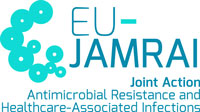Step by step guide for the implementation and assessment of Lunch-and-Learn Sessions
Lunch-and-Learn Sessions are brief, informal, and typically voluntary educational or informational meetings conducted during an employee’s or professional’s lunch break. They are designed to efficiently deliver focused content on specific topics, provide timely updates (e.g., on AMR trends or new AMS guidelines), enhance awareness, or introduce new skills in a relaxed and accessible setting. These sessions can be standalone events or part of a series, offering a flexible way to integrate learning into busy work schedules.

Planning a Lunch-and-Learn Sessions
The following steps should be taken into consideration when planning Lunch-and-Learn Sessions on AMR/AMS:
- Identify Specific AMR/AMS Focus and Objectives: Determine concise AMR/AMS topics suitable for a short session (e.g., “Top 5 misconceptions about antibiotic use in our facility,” “Quick guide to the new sepsis and AMS protocol,” “Hand hygiene: beyond the basics for AMR prevention,” “Understanding your facility’s antibiogram”). Clearly define what participants should know or be able to do after the session (Thompson et al., 2021).
- Content Design and Material Preparation: Develop engaging, targeted, and visually appealing content that can be covered effectively within a short timeframe (typically 30-75 minutes, according to Isaacs et al., 2025). Materials might include short presentations, infographics, brief video clips (Richardson et al., 2024, used videos), quick demonstrations, or educational handouts (Landwehr et al., 2021).
- Format Selection: Choose a format appropriate for the topic and audience. This could range from a didactic presentation of a new AMR guideline (Thompson et al., 2021) to more interactive or experiential approaches (Isaacs et al., 2025), or even “microlessons” (Howe et al., 2024, for brief educational inputs). Incorporate Q&A and discussion.
- Logistics and Promotion: Schedule sessions during established lunch breaks. Manage logistics such as room booking or virtual meeting setup. While food provision is not mandatory, it can enhance appeal and attendance. Clearly promote the sessions, outlining the topic, benefits, and duration.
- Engaging Delivery: Deliver the session in an interactive and energetic manner. Encourage questions, facilitate brief discussions, and ensure the atmosphere remains informal and conducive to learning during a break.
- Resource Provision: Provide concise take-away materials, such as a summary sheet of key AMR/AMS points, links to relevant guidelines, or contact information for further AMR-related queries.

Defining roles in a Lunch-and-Learn Sessions
Facilitator’s role: Prepare and deliver well-structured, concise, and highly engaging content relevant to AMR/AMS. Foster a relaxed, informal, and interactive atmosphere. Manage time effectively to respect participants’ break time. Be knowledgeable and prepared to answer questions succinctly.
Participant’s role: Attend voluntarily during their break. Engage actively by listening, absorbing key AMR/AMS messages, participating in any discussions or interactive elements, asking clarifying questions, and identifying practical takeaways relevant to their professional practice.

Assessing a Lunch-and-Learn Sessions
Methods
- Pre- and post-session brief surveys or quizzes to assess immediate changes in knowledge, attitudes, or confidence related to the specific AMR/AMS topic. (Thompson et al., 2021, and Landwehr et al., 2021, used pre-post surveys).
- Informal Q&A during the session to gauge understanding and engagement.
- Collection of participant feedback via short forms or polls at the end of the session, focusing on clarity, relevance, enjoyment, and perceived usefulness of the AMR/AMS information. (Perales et al., 2020, assessed enjoyment and perceived difficulty).
- Tracking attendance and engagement levels.
- Assessment of the feasibility and acceptability of the Lunch-and-Learn format for delivering AMR/AMS education within the specific workplace. (Isaacs et al., 2025, and Perales et al., 2020, evaluated these aspects).
Tools
Short, targeted questionnaires (paper or digital), quick online polls or “show of hands” for immediate feedback, sign-in sheets (optional), “minute paper” (participants write down one key learning point).

Suggested Lunch-and-Learn Sessions prototype
Target Audience: Antimicrobial Manufacturers, Food Producers, Dispensers, Educators.
Learning Objectives:
- Provide actionable, evidence-based “quick wins” for improving AMR stewardship or biosecurity relevant to the specific work context of Dispensers or Food Producers.
- Raise awareness of common AMR risks associated with specific practices in their field.
- Promote the adoption of one or two simple, impactful changes to daily routines to combat AMR.
Curriculum/Activities:
- A series of 3-4 monthly Lunch-and-Learn Sessions (30-45 minutes each).
- For Dispensers (e.g., community pharmacy): Topics like “Quick tips for counselling on proper antibiotic use”,
- “Identifying red flags for AMR in patient requests”, or “AMR and OTC: What can we do?”.
- For Food Producers: Topics like “Biosecurity boost: simple daily checks to reduce infection risk”, “Understanding withdrawal periods: beyond the label for AMR safety”, “Is this antibiotic necessary? Quick decision aid for common [Livestock-specific] issues”.
- Each session includes a brief presentation with clear visuals (infographics, short demo videos), a real-life mini-scenario for quick discussion (“What would you do?”), and distribution of a pocket card summarizing the “quick win.”
Evaluation of the Prototype’s Effectiveness:
- Pre- and post-series short quiz on the specific “quick win” topics covered.
- Collection of participant feedback after each session on clarity, practicality of the tips, and intention to implement.
- Six weeks after the series, a brief follow-up survey to assess self-reported adoption of any of the “quick win” practices discussed.
- Informal observation or collection of anecdotes from participants or managers about changes in awareness or practice related to the L&L topics.
References
- Howe, C. J., Carsey, E., Gamboa, J., Zhang, Y., & Lewis, B. (2024). Communicate to Care: Implementing Health Literacy in a Pediatric Ears, Nose, and Throat Clinic. Health Literacy Research and Practice, 8(3), e166–e174. https://doi.org/10.3928/24748307-20240819-02
- Hudak, N. M., Ross, E., Bynum, W., Pasha, N., Phillips, B., & Melcher, B. Q. (2021). Professional development for facilitators of interprofessional education: Participation and outcomes of a pilot program. Journal of Interprofessional Education and Practice, 24, 100431. https://doi.org/10.1016/j.xjep.2021.100431
- Isaacs, S. E., Bogardus, M., Thompson, M., Wu, S., & Howell, M. (2025). Development and Implementation of a 3-Week Whole-Food Plant-Based Vegan Diet Intervention for College Students. Journal of Nutrition Education and Behavior, 57(3), 242–252. https://doi.org/10.1016/j.jneb.2024.11.003
- Landwehr, K., Trees, W. J., & Reutman, S. (2021). A Quality Improvement Project to Improve Influenza Vaccination Rates Among Employees at an Onsite Employer-Based Health Clinic. Workplace Health and Safety, 69(10), 448–454. https://doi.org/10.1177/21650799211016906
- Ludden, T., Shade, L., Reeves, K., Welch, M., Taylor, Y. J., Mohanan, S., McWilliams, A., Halladay, J., Donahue, K., Coyne-Beasley, T., Dolor, R. J., Bray, P., & Tapp, H. (2019). Asthma dissemination around patient-centered treatments in North Carolina (ADAPT-NC): A cluster randomized control trial evaluating dissemination of an evidence-based shared decision-making intervention for asthma management. Journal of Asthma, 56(10), 1087–1098. https://doi.org/10.1080/02770903.2018.1514630
- Perales, J., Moore, W. T., Fernandez, C., Chavez, D., Ramirez, M., Johnson, D., Resendez, J., Bueno, C., & Vidoni, E. D. (2020). Feasibility of an Alzheimer’s disease knowledge intervention in the Latino community. Ethnicity and Health, 25(5), 747–758. https://doi.org/10.1080/13557858.2018.1439899
- Qua, K., Papp, K. K., Junk, D. J., Hooper, M. W., & Berger, N. A. (2020). Youth enjoy science program at the case comprehensive cancer center: Increasing engagement and opportunity for underrepresented minority students. Ethnicity and Disease, 30(1), 15–24. https://doi.org/10.18865/ed.30.1.15
- Richardson, J. D., Kline, H. L., Ko, B. Y., Hooper, A., Komanapalli, S., Alvarez-Del-Pino, J. D., & Yeh, E. S. (2024). Addressing Health Disparities in Hypertension: A Comprehensive Medical Elective and Survey Study Among Medical Students and Professionals. Medical Science Educator, 34(5), 1107–1115. https://doi.org/10.1007/s40670-024-02099-5
- Thompson, S., Johnson, D., Lindgren, T., Compton, L., & Chen, J.-L. (2021). Clinical practice guideline for primary care providers in the management of antidepressant-induced hyperhidrosis: A quality improvement project. Journal of the American Association of Nurse Practitioners, 33(11), 1080–1086. https://doi.org/10.1097/JXX.0000000000000478
